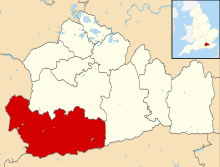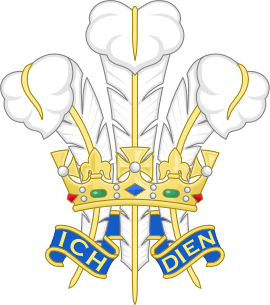Charterhouse School
Charterhouse is a boarding school in Godalming, Surrey. Originally founded by Thomas Sutton in 1611 on the site of the old Carthusian monastery in Charterhouse Square, Smithfield, London, it educates over 800 pupils, aged 13 to 18 years, and is one of the original 'great' nine English public schools. Today pupils are still referred to as Carthusians, and ex-pupils as Old Carthusians.
| Charterhouse School | |
|---|---|
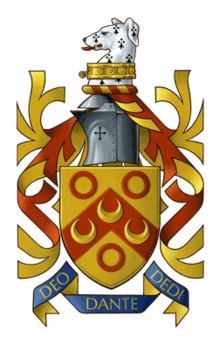 | |
.jpg) | |
| Address | |
Charterhouse Road , , GU7 2DX United Kingdom | |
| Coordinates | 51°11′48″N 0°37′21″W |
| Information | |
| Type | Public school Independent day and boarding school |
| Motto | Latin: Deo Dante Dedi (God having given, I gave)[1] |
| Religious affiliation(s) | Church of England |
| Established | 1611 |
| Founder | Thomas Sutton |
| Department for Education URN | 125340 Tables |
| Chair of Governors | Mrs Vicky Tuck |
| Headmaster | Dr Alex Peterken |
| Second Master | Mr Andrew Turner |
| Staff | ≈550 |
| Gender | Boys; co-educational (specialists) |
| Age | 13 to 18 |
| Enrolment | ≈800 |
| Houses | 12 |
| Colour(s) | Pink, blue and maroon |
| Publication | The Carthusian The Charterhouse Review |
| Former pupils | Old Carthusians |
| School song | Carmen Carthusianum |
| Website | charterhouse |
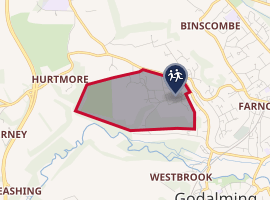
| |
Charterhouse charges full boarders up to £40,695 per annum (2019/20)[2] and is among the most expensive Headmasters' and Headmistresses' Conference (HMC) schools in the UK.[3] It educated the British Prime Minister Lord Liverpool and has a long list of notable alumni.
History
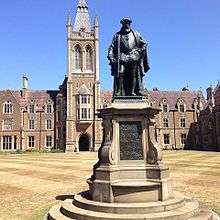
In May 1611, the London Charterhouse came into the hands of Thomas Sutton (1532–1611) of Knaith, Lincolnshire. He acquired a fortune by the discovery of coal on two estates which he had leased near Newcastle-on-Tyne, and afterwards, removing to London, he carried on a commercial career. In 1611, the year of his death, he endowed a hospital on the site of the Charterhouse, calling it the hospital of King James, and in his will he bequeathed moneys to maintain a chapel, hospital (almshouse) and school. He died on 12 December and subsequently the will was hotly contested but upheld in court, and the foundation was finally constituted to afford a home for eighty male pensioners (gentlemen by descent and in poverty, soldiers that have borne arms by sea or land, merchants decayed by piracy or shipwreck, or servants in household to the King or Queens Majesty), and to educate forty boys.
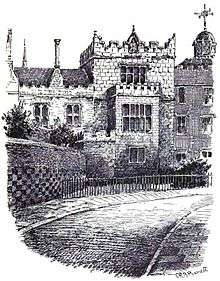
Charterhouse established a reputation for excellence in hospital care and treatment, thanks in part to Henry Levett, an Oxford graduate who joined the school as a physician in 1712. Levett was widely esteemed for his medical writings, including an early tract on the treatment of smallpox. Levett was buried in Charterhouse Chapel and his widow married Andrew Tooke, the master of Charterhouse.[4][5]
The school was moved to its present site in 1872 by the then headmaster, the Reverend William Haig Brown – a decision influenced by the findings of the Clarendon Commission of 1864.[6]
The school bought a 68-acre (270,000 m²) site atop a hill just outside Godalming. In addition to the main school buildings (designed by architect Philip Charles Hardwick), they constructed three boarding houses, known as Saunderites (once the headmaster's house, pronounced "sarnderites" rather than "sornderites"), Verites and Gownboys (for scholars, who were entitled to wear gowns). The school was built by Lucas Brothers,[7] who also built the Royal Albert Hall and Covent Garden.
As pupil numbers grew, other houses were built alongside the approach road, now known as Charterhouse Hill. Each was titled with an adaptation of the name of their first housemaster, such as Weekites, Daviesites and Girdlestoneites. The last of these is still referred to as Duckites, reflecting the unusual gait of its original housemaster, even though he retired well over 100 years ago. There are now the original four 'old' houses plus ten 'new' houses (currently three girls' houses), making fourteen boarding houses in total. The fourteen Houses have preserved a unique identity (each with its own tie and colours) and pupils compete against each other in both sports and the arts. There are now plans underway to build two more houses to cater for the new girls being welcomed from Year 9 upwards in 2021.
The school continued to expand over the 20th century. Further land was bought to the north and west, increasing the grounds to over 200 acres (809,000 m²), and a new school chapel was designed by Sir Giles Gilbert Scott (perhaps best known for designing the red telephone box) and consecrated in 1927 to commemorate almost 700 pupils who died in the First World War, making it the largest war memorial in England. Around 350 names have been subsequently added to commemorate those who died in the Second World War and other more recent conflicts. Most still attend a short chapel service there six times a week. The school also keeps a small archives library opposite the History block, where it is traditional for Fourths (Year 9) to do an archives project about a particular Old Carthusian killed in the First World War.
An addition to the campus was seven new Houses, built in the 1970s, replacing late Victorian boarding houses which were demolished in 1977. Other newer buildings include the Art Studio, the John Derry Technology Centre, the Ben Travers Theatre, the Ralph Vaughan Williams Music Centre, the Halford Hewitt Golf Course, the Queen's Sports Centre, the Sir Greville Spratt athletics track and Chetwynd, a hall of residence for girls. In 2003, the School renovated its onsite Library. 2006 saw the opening of The Beveridge Centre for the Social Sciences. In 2007, a £3m Modern Languages building was completed.
.jpg)
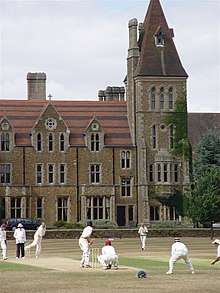
The school has a top 60 placing in the A level league tables, and in 2011 over 80% of pupils are awarded an A* or A grade at GCSE. In 2009, the school announced its decision to switch from A Levels to the International Baccalaureate and Cambridge Pre-U.[8] In 2012 Charterhouse had its best set of Cambridge Pre-U results with 96% of examinations taken awarded Distinction or Merit grades. Seventy-eight pupils achieved Distinctions (or their A level equivalent) in all subjects taken and twenty-one achieved the equivalent of A level A* grades in all their subjects. Twenty pupils were offered places at Oxford or Cambridge.[9]
In 2007, Roy Hattersley, former Deputy Leader of the Labour Party and minister, reported on a visit to Charterhouse in the Guardian newspaper. After describing his impression that "[The chapel]'s geometric spires and minarets proclaim complete confidence that Charterhouse educates men who are destined to rule the universe", he said: "Academically and pastorally, it is near to beyond criticism. And after only a brief glimpse of the school, I have no doubt that I would have been ecstatically happy there. But its existence allows the rich and the powerful to ignore the world beyond its boundaries." He therefore concluded that his aspiration to abolish private education in the 1970s was "totally justified".[10]
The 2009 Ofsted Social Care Inspection Report noted that 'The provision for "Helping children achieve well and enjoy what they do" is rated as outstanding.' and 'This is a good school, in which boarders' welfare is promoted by a strong approach to countering bullying and child protection. Boarding staff have good relationships with the boarders, and boarders can list a range of people who they can talk to if they are worried or have concerns.'[11]
The 2011 Independent Schools Inspectorate Report noted that 'The quality of pupils' achievements is excellent. Pupils are extremely well educated. They attain extremely high standards in external examinations and make exceptional progress in their learning because of their positive attitudes to study, dedicated and often inspiring teaching, and an academically challenging curriculum that is adapted to suit all needs. The curriculum is enriched by an outstanding range of activities'.[12]
The 2017 ISI Educational Quality Inspection Report noted that ‘Pupils' academic and other achievements are high and often exceptional. Pupils' successes in external competitions, in academic distinctions and in sport, music and the creative and aesthetic arts are exceptional. Pupils' social development is outstanding. Pupils are polite, courteous and respectful of one another and of the adults who care for them. Relationships between pupils and staff are excellent. Pupils mature into independent and self-motivated pupils over the course of their time at school and are extremely well prepared, not only for the next stage of their lives, but also to contribute to society at large.’[13]
Charterhouse originally accepted boys only. The school began accepting girls in sixth form in 1971.[14] In 2017 the school announced that it is moving to full co-education from the age of 13, and will welcome the first girls into Year 9 in September 2021. There will be girls in every year group from September 2023.[15]
School terms
There are three academic terms (known as Quarters) in the year,
- The Oration Quarter (OQ), from early September to mid December.
- The Long Quarter (LQ), from mid January to late March. Therefore, it traditionally had the distinction of being the shortest third of the school year, despite its name.
- The Cricket Quarter (CQ), from late April to late June or early July.
Houses
There are four old boarding houses and ten new houses in the White Book (a directory of names) order. In Charterhouse vocabulary an old house is one which was founded in the early years of the school, as opposed to the new houses which were created later and are situated away from the main school. They are all distinguished by the colour of the pupils' ties, umbrellas and football team's stripes.
| House | Abbr. | Type | Colour | Housemaster/housemistress | |
|---|---|---|---|---|---|
| Saunderites | S | Old | Orange[16] | Mrs SC Allen Teaches Biology, Master in Charge of Athletics[17] | |
| Verites | V | Old | Light blue[18] | EJ Reid Teaches Mathematics[18] | |
| Gownboys | G | Old | Maroon[19] | A Marshall-Taylor Teaches Modern Languages[20] | |
| Girdlestonites (known as 'Duckites') | g | Old | Silver[21] | JS Hazeldine
Teaches Economics[22] | |
| Lockites | L | New | Light Green[23] | AM Hunt Teaches Mathematics[23] | |
| Weekites | W | New | Light Red[24] | EF Poynter Teaches English[24] | |
| Hodgsonites | H | New | Dark Blue[25] | IS Richards Teaches Government and Politics[25] | |
| Daviesites | D | New | Dark Green[26] | SD James Teaches Economics | |
| Bodeites | B | New | Old Gold[27] | A Aidonis Teaches Classics[27] | |
| Pageites | P | New | Lilac[28] | PJ Martin Teaches Philosophy[28] | |
| Robinites | R | New | Purple[29] | AE Brinkley Teaches Business Studies and History | |
| Fletcherites | F | New Girls |
Turquoise-blue[30] | Miss AC Brooking Teaches French[30] | |
| Sutton | Su | New Girls |
Pink | JT Lambeth Teaches Biology and Chemistry | |
| Chetwynd | C | New Girls |
MX Creer Teaches English | ||
In Autumn 2010, a new house was opened for sixth-form pupils, called Fletcherites, named after Frank Fletcher, a former headmaster. The house moved into the old Great Comp building, now renovated. Verites, Saunderites and Gownboys houses predate the move to Godalming in 1872 and are known as the "old” houses. However, Girdlestoneites is now treated as one of the "old houses" because it, along with Verites, Saunderites and Gownboys, are the only houses still in their 1870s buildings, while all the rest are in their 1970s replacements. Technically the “old” houses plus Girdlestoneites are known as “block” houses, due to their location in the main 1870s block of buildings. Saunderites is named after its first Housemaster Dr. Saunders (Headmaster 1832–53) and it was the Headmaster's house, in that the headmaster would not only run the school but one of the houses. Unfortunately, the dramatic increase in the size of the school and the increasing difficulties in running such a school have meant that the Headmaster can no longer do this. Gownboys was named not after their original housemaster, but because it was the scholars' house, although scholars were distributed across all the houses after the transfer to Godalming. As was tradition, scholars wore gowns with their uniform and were treated as superior to other boys. There is no longer such a tradition and the scholars are now distributed throughout the various houses, on a random but numerically equal basis. There are still scholars in Gownboys, but in no greater proportion than any other house.
Verites is a contraction of Oliverites (Oliver Walford, School Usher 1838–55) and hence 'Verites' is pronounced as if the 'Ver' is from Oliver not as from 'very'. The records of the house run back to the start of the last century, but previously it was just called 'Boarders House No.2'.
‘Girdlestoneites' first housemaster was Frederick Girdlestone, who was said to walk like a duck. Girdlestonites has therefore been unofficially known as 'Duckites' ever since, but since this was 'insulting' slang it was never written down or used officially. This latter restriction has now largely fallen by the wayside and even the school magazine uses Duckites in print occasionally.
All new Houses apart from Bodeites are named after their founders (although Robinites was originally Robinsonites). Bodeites was originally Buissonites, named after the Head of Languages at the time. He ran off with the matron, and so the house was renamed Bodeites after the replacement, Mr Bode.[31] This did lead to some confusion at the time of naming the houses because some housemasters moved to houses named after their colleagues.
Robinites was a 'back passage house' when the school first moved to Godalming and boys stayed there for no more than two years until they could be transferred to one of the other houses. It now has normal status. There was also another passage house known as Laleham, but this has ceased to exist.
With the move to full co-education planned for September 2021, specialist girls' houses have opened for the first time in the school's history, those being Sutton, Chetwynd, Fletcherites (now no longer a mixed house), and Northbrook.
All pupils belong to one of the 14 houses, and boarding boys will sleep in the boarding house; their housemaster will live in "private side" attached to the house. Charterhouse has traditionally had very few day boys. In the 1870s the statutes of the school limited them to 10 (excluding sons of masters) and even in the late 1980s the number was only around 25 (some of whom were the sons of masters). Formerly, boarding girls were assigned a House and were fully involved in their House life but at night, and would sleep in halls of residence (e.g. Chetwynd) which were not treated as houses. These halls of residence are more modern than the 'new' Houses. With the advent of full co-education, girls have their own houses which are developing their own identities.
Teachers belong to Brooke Hall (the teachers' common room building).
Uskites was a temporary house opened in 1872 by Mr Stewart, the writing and chemistry instructor from the old Charterhouse. It was closed in 1878 and the pupils redistributed. The building itself (on Peperharow Road) was bought by a schoolmaster, and later used by the School as a sanatorium. It is now masters' accommodation. Mr Stewart named the house because he likened the valley of the River Wey (where the house lies) with the valley of the River Usk.
Memorial Chapel
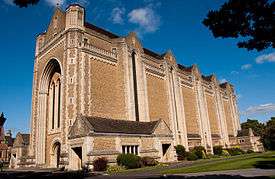
Memorial Chapel, designed by Sir Giles Gilbert Scott and consecrated in 1927, commemorates the Carthusians who died in action: 700 in World War I and 350 in World War II. The whole School meets here three days each week for a short service at 08:30, and on Friday evenings for Evensong or a School Eucharist. On Fridays, when there is an Evening service, Catholic pupils may instead attend Mass in the Founder's Chapel. Parents are welcome at Friday services, but tickets are required for Remembrance Sunday and the Carol Service.
Thursday morning chapel is reserved for congregational singing practice. Attendance at all chapel services is compulsory, except where individual exemptions are granted on religious grounds.
Chapel provides a variety of worship experience: hymn-singing; Psalm chanting; the choir performs a repertoire of Church Music; Candle-lit Carols; Eucharists in Millennium Chapel; Remembrance Sunday with the sounding of The Last Post and The Silence.
Each year there is a Confirmation Service in late January and pupils from any year group can be prepared for this.
The school retains the old chapel used by the school prior to 1927. However, when the school first moved to Godalming even this was not built, and the pupils walked the 2 miles to Shackleford Church. Pupils subsequently benefited, because the time taken for the walk precluded the continuance of Sunday school, which ran from 10:00 to 10:30 on Sundays, which has remained a non-teaching day ever since.
Uniform
- Under School
The Under School consists of the first three years of attendance at Charterhouse, being the Fourth Form, the Removes and the Fifth Form (GCSE year). Pupils in Under School wear a weekday uniform consisting of a white or blue shirt, house tie, grey trousers, blue jumper, tweed jacket and leather shoes. Sunday dress consists of a dark suit of pinstriped or plain design. A waistcoat is optional. Variations include various society and school honours' ties.[32]
Transition from the Under School to the Upper School occurs upon successful completion of the GCSE exams.
- Specialists ('The Upper School')
The Specialists (Lower and Upper Sixth Forms) constitute the last two years of attendance at Charterhouse, and form the Upper School. Having completed the GCSE exams successfully, 'First & Second Year Specialists' (as they are colloquially referred) spend two years studying for their 'A-Level' examinations, usually in three subjects, although some students will read for four or five.
Male Specialists have their own variations on the Under School Dress. Instead of a tweed jacket, Specialists wear a navy blue blazer with gold or blue buttons on the sleeves.[33] Sunday dress remains the same as in the Under School. Historically, those in Gownboys were permitted to wear gowns as a mark of their scholarly status, but this is no longer permitted, as Gownboys is not the only house in which scholars reside. Specialists may also wear pink shirts and silver or nickel cuff-links.
Females join the school as Specialists and have a separate Dress Code to adhere to. Their uniform consists of a pink and white striped shirt, or a blue and white striped shirt, a black blazer, black skirt, and/or black trousers, a house pin (or tie) to signify which House they belong to, and black leather shoes.[34]
Whether in Under or Upper School, any pupil who has been awarded his House or School 'Colours' for sport or culture, may wear his 'Colours' tie in place of his house tie. School monitors may also wear their monitor tie instead of a house tie, if they so choose. For further on this, please see below, under "School Honours".
- Summer dresses
During Cricket Quarter, the school uniform can vary slightly from that of the two preceding terms. Boys may wear cravats in house colours instead of ties and are permitted to wear straw Boaters similar to the 'Harrow Hat' found at Harrow School, but these are almost never worn by the majority of pupils. Boys in the Under School may also wear navy blazers similar to those worn by the Specialists. As well as these variations, boys may roll up their sleeves in hashes unless asked not to by a beak.
- Members of the 1st XI Cricket Team have their own variation on summer dress which is described later in the article.
- School Honours
School Honours is the Colours system rewarding pupils in various fields with variations on school dress. They are as follows:
House colours – House colours are a variation on the house tie. Colours awarded for house sport prowess have thicker stripes in the House colour, whereas those awarded for cultural prowess have thin doubled striped.
School colours – School colours are awarded for services to School sport, culture and other areas deemed worthy. They all have a similar design of a solid colour and are covered in the crest of Thomas Sutton, the school's founder. However, they come in varying colours: The Head of School – The Heads of School (head boy and deputy, as well as the head girl and deputy head girl) is permitted to wear a Pink tie adorned with Sutton Crests. 1st XI Major Sports – Members of the 1st Team in major school sports (football, hockey and cricket) are permitted to wear maroon ties. Minor Sports – Holders of colours in Minor Sports are permitted to wear a silver ties. Academic/Scholars – Holders of Academic or Scholars colours are permitted to wear a Cambridge Blue tie. Culture – Those deemed worthy enough in cultural fields are permitted to wear a purple tie. Service – Brown ties are awarded for commendable service to the school community. Most frequently they are awarded by the CCF.
1st XI Cricket – Members of the 1st XI Cricket team are permitted to wear pink blazers with Sutton's Crest on the front pocket to Hashes on match days (usually Saturdays).
Greyhounds – Every year a few Carthusians are given Greyhound awards for outstanding service to the school. Those awarded the prize are permitted to wear a navy blue tie with rampant gold greyhounds, the greyhound being a notable feature of the coat of arms of Thomas Sutton.
Academic – Pupils who have gained distinctive academic achievements are awarded the Academic Tie and are referred as Scholars of the school. They are permitted to wear a Cambridge Blue tie with the Sutton Crest.
Culture – Pupils who have contributed to the school distinctively in terms of culture (music, drama etc.) are awarded the Culture Tie, which has a deep purple colour with the Sutton Crest.
Events
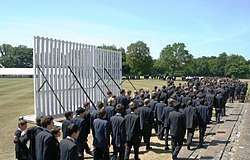
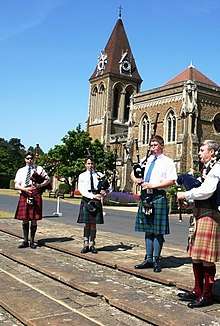
Carthusian Day is the main social event of the school calendar. It is held on day preceding the Exeat in CQ and Sunday dress is worn. The day is intended for the parents and families of Carthusians to visit the school. Speeches are made and Sports events played: including the annual Cricket and Golf matches between Carthusians and Old Carthusians. It also gives parents the chance to see their sons' and daughters' work (such as the traditional Archives project done by Fourths on old Carthusians killed in World War I).
Founder's Day is celebrated every year to commemorate the founding of the school and to thank the founder and benefactor Thomas Sutton. It is considered one of the most important days of the year and is held on the last day of OQ. The day consists of 'clearing up' in houses before 'Founders Feast', a large feast for the whole school where Black Tie is worn. The feast is followed by games and activities.
St. Andrew's Day is celebrated by an annual ball hosted by the historical 'Scottish Dancing society. On St. Andrews Day pupils are permitted to wear traditional Scottish dress including a Kilt, Ghillies and a Sporran.
'The 50 Mile Walk' is an annual event for the 1st Year specialists held at the end of CQ. It consists of walking a 50-mile (80 km) stretch from Brighton to the Brooke Hall arch and taking regular Hashes the next day. The March originates from the 1950s when the American Navy SEALs challenged the School, saying that only they could walk 50 miles (80 km) and go to work the next day. Those who complete the walk in less than 24 Hours are awarded a special '50' tie, which until 2006 consisted of a navy blue tie with the school crest that has a '50' written below it. The current tie is a thickly striped affair in Pink (for the school), Green (for the countryside) and Blue (for the night)
Leavers' Day is the last day of CQ when the Second Year Specialists come to the end of their school careers. After the Leavers Chapel, the entire school does 2 lap around 'Green' while several men dressed in Scottish traditional Scottish dress play the bagpipes. The leaving Second Year Specialists do an extra lap signifying their loyalty to the school.
'Lack of Talent' is an annual show of Carthusian musical talent and sketches run entirely by pupils and held in the BTT during the start of OQ. It is usually hosted by two second year Specialists and acts are selected by a panel of pupils in the Second Year Specialists. Such acts are predominantly music based, however comedy sketches have become increasingly popular (as they were a large part of the original Lack of Talent in 2000) with many of the staff looking forward to the Brooke Hall parody sketch that has become a regular feature. It is one of the few productions in the school's theatre that students and visitors have to pay a fee to see, originally with the concept this would go to global, less obvious charities and raise peoples awareness of their causes.
Monitors
Monitors are chosen pupils who are deemed to have the best qualities in leadership and achievement. Each house has at least one monitor, who is appointed Head of House (the most senior pupil in house). On a school-wide level one monitor is appointed the Head of School, and a deputy is appointed to assist. Monitors may wear Navy blue ties and Navy scarves with an embroidered crest. Monitors are also permitted to ride bikes to and from hashes as well as out of Hash time.
House Apostles
The Headmaster's Essay Society, also known as the 'House Apostles' is a historical society of twelve Carthusians deemed to be the most intellectual in the school. It is the most exclusive club to get into at Charterhouse. The students are invited by the Headmaster to present papers on chosen subjects on Monday evenings and meetings are held in the Headmaster's House. All members are allowed to wear Cambridge Blue Academic ties or scarfs.
Sports
Today, pupils take part in a range of sporting activities. The former England batsman and captain Peter May was educated at Charterhouse. Martin Bicknell, the former Surrey and England seam bowler joined the school as head of cricket following his retirement from the sport in 2006.
In 1999–2000, the Charterhouse first XI reached the final of the ISFA Cup, after winning all their previous rounds away from home, but were narrowly beaten 0–1 in the final at the Leicester City ground by Shrewsbury. The school first XI of the year 2006–7 again reached the ISFA cup final, losing on penalties after a one-all draw with Hampton. One year later, the school first XI again qualified for the ISFA cup final against Millfield. Because of poor weather conditions, it was decided that the match would be played on one of Charterhouse's pitches instead of the usual Walkers Stadium or the replacement at Woking F.C. stadium. The team won this match on penalties. In March 2011, the school reached another ISFA final, a fixture with Eton after knocking out Repton and Millfield in the quarter and semi-final respectively. They ran out comfortable 2–0 winners on the day.
Origins of football
Charterhouse has a historic joint claim to having founded Association Football, which remains the main Winter sport at the school. During the 1840s at both Charterhouse and Westminster School pupils' surroundings meant they were confined to playing their football in the cloisters, making the rough and tumble of the handling game that was developing at other schools such as Rugby impossible, and necessitating a new code of rules. During the formulation of the rules of the Association Football in the 1860s representatives of Charterhouse and Westminster School pushed for a passing game, in particular rules that allowed forward passing ("passing on"). Other schools (in particular Eton College, Shrewsbury School and Harrow) favoured a dribbling game with a tight off-side rule. It is claimed that Stoke Ramblers was formed in 1863 when former pupils of Charterhouse School formed a football club while apprentices at the North Staffordshire Railway works in Stoke-on-Trent.[35] By 1867 the Football Association had chosen in favour of the Charterhouse and Westminster game and adopted a "loose" off-side rule that permitted forward passing.[36] The modern forward-passing game was a direct consequence of Charterhouse and Westminster football.
In the early years of the FA Cup, teams formed of ex-pupils from these schools dominated the competition. The Old Carthusians F.C. (the name for the team composed of Charterhouse alumni) won the cup in the 1880–81 season, beating the Old Etonians in the final, and were semi-finalists in the two years that followed. The public school system also provided many of the first England internationals. They included Charles Wreford-Brown, who is often credited for inventing the word "soccer". He was a pupil at Charterhouse in the early 1880s, and played football for the Old Carthusians and for the national side in the 1890s, including several appearances as captain.
During the past few years, Charterhouse has performed well in the Independent Schools Football Association cup. In 2007, Charterhouse were runners-up but in 2008 they were able to beat Millfield and win the cup. They had another success in 2010 with a 2–0 victory in the final over Eton College.
Cricket ground
The first recorded match on the school cricket ground came in 1859, when the school played Marlborough College. From its inception, the school has used the ground to take on a number of colleges in England.[37] The cricket ground has held a single List-A match, which was played between Surrey and Warwickshire in the 1972 John Player League.[38] Starting in 2006, the ground has held a number of Surrey Second XI fixtures in the Second XI Championship and Second XI Trophy.[39][40]
Herbarium
The School's Herbarium carries the Index Herbariorum designation GOD and is maintained as The Charterhouse School Herbarium[41] in the University and Jepson Herbaria, University of California, Berkeley.
The scope of the collections is mainly the British Isles, although some plants are from Europe, South Africa and eastern North America. The principal collectors were James Edward Moxon, Rev. George Brown Moxon, Rev. Tullie Cornthwaite, Rev. Samuel Titmas (first curator of Charterhouse Museum), Frederick Yorke Brocas, Andrew Bloxam, William Gardiner, James Buckman and John Drew Salmon. The collections are currently being digitised and being released by the Botanical Society of Britain and Ireland, on the herbaria@home[42] website.
Fees
In any given year, there is some contention about which is the most expensive public school in England, depending on whether one compares day fees or boarding fees. In December 2012 Charterhouse was reported to be the fifth most expensive for boarding pupils.[43] Charging up to £11,415 per term in 2014/15, Charterhouse is the 7th most expensive HMC boarding school in the UK.[3] For the 2018/19 academic year, boarding fees are £39,165 and day boarding is £32,364.[44]
Controversy
School fees cartel (2005)
In November 2005, the school was one of fifty of the country's leading independent schools which were found guilty of running an illegal price-fixing cartel, exposed by The Times newspaper, although the schools made clear that they had not realised that the change to the law (which had happened only a few months earlier) about the sharing of information had subsequently made it an offence.[45] Each school was required to pay a nominal penalty of £10,000 and all agreed to make ex-gratia payments totalling three million pounds into a trust designed to benefit pupils who attended the schools during the period in respect of which fee information was shared.[46] Mrs Jean Scott, the head of the Independent Schools Council, said that independent schools had always been exempt from anti-cartel rules applied to business, were following a long-established procedure in sharing the information with each other, and that they were unaware of the change to the law (on which they had not been consulted). She wrote to John Vickers, the director-general of the Office of Fair Trading saying: "They are not a group of businessmen meeting behind closed doors to fix the price of their products to the disadvantage of the consumer. They are schools that have quite openly continued to follow a long-established practice because they were unaware that the law had changed."[47]
Gary Lineker accusations (2010)
In August 2010, former English footballer Gary Lineker publicly accused Charterhouse of failing his son, George, in his bid for a place at university.[48] Lineker claimed that the school had used him as a 'guinea pig'[49][50] by ditching A-Levels for the new Cambridge Pre-U. The school reacted by saying it was proud of its students' results.[51] John Witheridge, then headmaster, defended the choice of the Pre-U as being more academically rigorous and educationally valid than the current A-Level standard in an article in The Spectator in August 2010.[52]
Richard Pleming (2015)
In September 2015, it was reported that the school had seen a "revolt" against Richard Pleming, the headmaster, from pupils and parents who accused him of using "draconian methods".[53] In October 2016 it was announced that Pleming would step down from his position as Headmaster in January, after three years. The move attracted particular attention given that the unusual decision was taken for Pleming to step down during Long Quarter, and before the end of his contract. The school's Second Master, Andrew Turner, assumed the position of headmaster until the end of the academic year, with Pleming continuing to work at the school fulfilling his teaching duties until the end of the academic year.
Proposed development of playing fields (2018)
Protests from the local community were triggered by a plan to sell off playing fields in 2018,[54] due to the land being part of a "green belt" area, where new developments are prohibited.
Historic sexual abuse
In March 2012, it was reported that a 16-year-old had filmed fellow pupils while they showered, and stored the images on his laptop. The boy was taken into custody by Surrey Police for questioning. A police inquiry was subsequently established.[55]
In April 2013, a physics teacher, Dr Dean Johnson, resigned after allegations of an 'inappropriate relationship' with a former teenage girl pupil led to a police investigation. A police investigation followed, and resulted in a conviction after trial by a jury for the teacher who was found to be in possession of extreme pornography, which depicted a woman being hanged, in 2015; he was given eight-month prison sentence, suspended for two years.[56] A professional misconduct panel later found:
- that he had sex with her in the classroom at the school;
- that he had communicated his fantasies to the girl over Facebook;
- that he had asked what her underwear size was before buying stockings and presenting them to her gift-wrapped;
- that the relationship became sexual weeks after the girl turned 18.[57][58]
In 2018, Cathy Newman, who attended the school on a scholarship said that she was humiliated and sexually harassed while a pupil at the school. Other ex-pupils told The Times about experiences including a humiliating initiation ceremony at the school and flashing and groping incidents.[59][60][61] Rebecca Willis, commenting on similar themes around the time reiterated these themes, but also commented on racism which resulted in Asian children leaving.[62] The school has subsequently contacted former pupils to ask them to share concerns.[60]
Film location
The school is occasionally used as a film location. It was used to represent the Palace of Westminster in the 2018 BBC drama Bodyguard.[63] It has previously been used in The Boys are Back, Jupiter Ascending, St Trinians 2, The Mystery of Edwin Drood (an adaptation of a Charles Dickens novel), Foyle's War, An Ideal Husband, and Vampire Academy.[64][65]
Headmasters
- 2018— Dr. Alex Peterken
- 2017–2018 Andrew Turner
- 2014–2017 Richard Pleming
- 1996–2013 The Revd John Witheridge
- 1995–1996 Clive Carter
- 1993–1995 Peter Hobson
- 1982–1993 Peter Attenborough
- 1973–1981 Brian Rees
- 1965–1973 Oliver van Oss
- 1952–1964 Brian W. M. Young
- 1947–1952 George Turner
- 1935–1947 Sir Robert Birley
- 1911–1935 Frank Fletcher
- 1897–1911 Gerald Henry Rendall
- 1863–1897 The Revd William Haig Brown
- 1858–1863 Richard Elwyn
- 1853–1858 Edward Elder
- 1832–1853 Augustus Page Saunders
- 1811–1832 The Revd John Russell
- 1791–1811 Matthew Raine
- 1769–1791 Samuel Berdmore
- 1748–1769 Eberard Lewis Crusius
- 1731–1748 James Hotchkis
- 1728–1731 Andrew Tooke
- 1679–1728 Thomas Walker
- 1662–1679 Thomas Watson
- 1654–1662 Norris Wood
- 1651–1654 Thomas Bunkley
- 1643–1651 Samuel Wilson
- 1628–1643 Robert Brooke
- 1626–1628 William Middleton
- 1624–1628 Robert Grey
- 1614–1624 Nicholas Grey
Old Carthusians
Former pupils are referred to as Old Carthusians, and current pupils as Carthusians.
Victoria Cross holders
Three Old Carthusians have won the Victoria Cross:
- Victoria Cross
- Hunza-Nagar Expedition, India
- Lieutenant Guy Hudleston Boisragon, VC (At Charterhouse from Oration Quarter (OQ) (Autumn Term)1878 to OQ 1880). He later achieved the rank of Brigadier. (1864–1931)
- Mohmand Campaign, Bilot, India
- Lieutenant James Morris Colquhoun Colvin, VC, (At Charterhouse from Cricket Quarter (CQ) (Summer Term) 1884 to CQ 1888). He later achieved the rank of colonel. (1870–1945)
- First World War
- Lieutenant Eric Archibald McNair, VC (At Charterhouse from CQ 1907 to CQ 1913 – was Head of the School). He later achieved the rank of captain. (1894–1918)
- Hunza-Nagar Expedition, India
See also
- List of Victoria Crosses by School
- List of English and Welsh endowed schools (19th century)
References
- "Social Responsibility". Charterhouse School. Archived from the original on 26 December 2018. Retrieved 26 December 2018.
- Charterhouse. "Fees" Archived 23 November 2012 at the Wayback Machine. Retrieved 12 November 2017.
- "Archived copy" (PDF). Archived from the original on 5 March 2016. Retrieved 29 February 2016.CS1 maint: archived copy as title (link) CS1 maint: BOT: original-url status unknown (link)
- The Roll of the Royal College of Physicians of London – Royal College of Physicians of London –. Longman, Green, Longman, and Roberts. 1861. p. 21. Retrieved 7 April 2015 – via Internet Archive.
henry levett charterhouse.
- The Roll of the Royal College of Physicians of London: 1701 to 1800 – William Munk, G. H. Brown –. The College. 1878. p. 22. Retrieved 7 April 2015 – via Internet Archive.
henry levett charterhouse.
- "Charterhouse History". Charterhouse School. Archived from the original on 23 April 2019. Retrieved 26 December 2018.
- "Charles Lucas". Oxforddnb.com. Retrieved 7 April 2015.
- "Schools ditching A-levels for diploma programme". Getsurrey.co.uk. 28 January 2009. Archived from the original on 24 February 2012. Retrieved 7 April 2015.
- "Examination REsults". Charterhouse.org.uk. Archived from the original on 4 October 2013. Retrieved 7 April 2015.
- Hattersley, Roy (17 July 2007). "Roy Hattersley visits Charterhouse". The Guardian. London. Archived from the original on 30 December 2016. Retrieved 11 December 2016.
- "Charterhouse : Inspection report for boarding school" (PDF). Ofsted.gov.uk. Archived from the original (PDF) on 3 November 2012. Retrieved 7 April 2015.
- "Charterhouse – ISI – Independent Schools Inspectorate". ISI.net. Archived from the original on 15 May 2012. Retrieved 7 April 2015.
- "ISI Inspection Reports – Charterhouse". www.charterhouse.org.uk. Archived from the original on 12 October 2018. Retrieved 12 October 2018.
- "Charterhouse set open a sixth-form day house". The Independent. Retrieved 23 June 2019.
- "Full coeducation at Charterhouse". Archived from the original on 12 October 2018. Retrieved 12 October 2018.
- "Saunderites". charterhouse.org.uk. Archived from the original on 1 May 2019. Retrieved 1 May 2019.
- "Saunderites". Charterhouse.org.uk. Archived from the original on 4 October 2013. Retrieved 7 April 2015.
- "Verites". charterhouse.org.uk. Archived from the original on 1 May 2019.
- "Gownboys". charterhouse.org.uk. Archived from the original on 1 May 2019.
- "Mr Andrew Marshall-Taylor - Charterhouse". www.charterhouse.org.uk. Retrieved 8 August 2020.
- "Girdlestonites". charterhouse.org.uk. Archived from the original on 1 May 2019.
- "Mr James Hazeldine - Charterhouse". www.charterhouse.org.uk. Retrieved 8 August 2020.
- "Lockites". charterhouse.org.uk. Archived from the original on 1 May 2019.
- "Weekites". charterhouse.org.uk. Archived from the original on 1 May 2019.
- "Hodgsonites". charterhouse.org.uk. Archived from the original on 1 May 2019.
- "Daviesites". charterhouse.org.uk. Archived from the original on 1 May 2019. Retrieved 1 May 2019.
- "Bodeites". charterhouse.org.uk. Archived from the original on 1 May 2019. Retrieved 1 May 2019.
- "Pageites". charterhouse.org.uk. Archived from the original on 1 May 2019. Retrieved 1 May 2019.
- "Robinites". charterhouse.org.uk. Archived from the original on 1 May 2019. Retrieved 1 May 2019.
- "Fletcherites". charterhouse.org.uk. Archived from the original on 1 May 2019. Retrieved 1 May 2019.
- John Dann (2017). Maud Coleno’s Daughter: The Life of Dorothy Hartman, 1898–1957. p. 166. ISBN 978-1785899-713.
- "Boys Uniform List and Dress Code" (PDF). charterhouse.org.uk. Archived from the original (PDF) on 1 May 2019.
- "Boys Uniform List and Dress Code" (PDF). charterhouse.org.uk. Archived from the original (PDF) on 1 May 2019.
- "Girls Uniform List and Dress Code" (PDF). charterhouse.org.uk. Archived from the original (PDF) on 1 May 2019.
- "1863–1888 in the Beginning". Stoke City F.C. Archived from the original on 19 October 2008. Retrieved 22 June 2007.
- Marples, Morris. A History of Football, Secker and Warburg, London 1954, page 150
- "OTHER MATCHES PLAYED ON CHARTERHOUSE SCHOOL, GODALMING (287)". Cricketarchive.com. Archived from the original on 28 May 2018. Retrieved 7 April 2015.
- "LIST A MATCHES PLAYED ON CHARTERHOUSE SCHOOL, GODALMING (1)". Cricketarchive.com. 28 May 1972. Archived from the original on 28 May 2018. Retrieved 7 April 2015.
- "SECOND XI CHAMPIONSHIP MATCHES PLAYED ON CHARTERHOUSE SCHOOL, GODALMING (3)". Cricketarchive.com. Archived from the original on 28 May 2018. Retrieved 7 April 2015.
- "SECOND XI TROPHY MATCHES PLAYED ON CHARTERHOUSE SCHOOL, GODALMING (5)". Cricketarchive.com. Archived from the original on 28 May 2018. Retrieved 7 April 2015.
- "University and Jepson Herbaria". Ucjeps.berkeley.edu. 10 August 2007. Archived from the original on 7 June 2011. Retrieved 7 April 2015.
- "herbaria@home project homepage". Herbariaunited.org. Archived from the original on 23 March 2010. Retrieved 7 April 2015.
- "The top ten most expensive schools in the UK". Geraldinehackett.com. 3 December 2012. Archived from the original on 1 April 2015. Retrieved 7 April 2015.
- "Fees". charterhouse.org.uk. Archived from the original on 1 May 2019.
- Halpin, Tony (10 November 2005). "Independent schools face huge fines over cartel to fix fees". The Times. London. Archived from the original on 7 October 2008. Retrieved 25 July 2008.
- "OFT names further trustees as part of the independent schools settlement" (Press release). 21 December 2006. Archived from the original on 10 June 2008.
- "Private schools send papers to fee-fixing inquiry". The Daily Telegraph. London. 1 March 2004. Archived from the original on 25 June 2013. Retrieved 15 March 2011.
- 23 August 2010 (23 August 2010). "Gary Lineker's son fails to get grades for place at university – 3am & Mirror Online". Mirror.co.uk. Archived from the original on 15 January 2012. Retrieved 7 April 2015.
- "Gary Lineker attacks Charterhouse school over son's results". The Daily Telegraph. London. 23 August 2010.
- "Gary Lineker's anger at 'guinea pig' son's school | Metro News". Metro.co.uk. 24 August 2010. Archived from the original on 27 August 2010. Retrieved 7 April 2015.
- Garner, Richard (24 August 2010). "Lineker blames £25,000-a-year school after son fails to make grade – Education News – Education". Independent.co.uk. Archived from the original on 7 December 2011. Retrieved 7 April 2015.
- "An answer to the A-level debacle – and Gary Lineker". The Spectator. Archived from the original on 2 March 2012. Retrieved 10 October 2011.
- Javier Espinoza (23 September 2015). "'Pleming Out': Revolt over 'draconian' Charterhouse head". The Daily Telegraph. Archived from the original on 28 May 2018. Retrieved 2 April 2018.
- "Charterhouse school to sell off playing fields". Eagle Radio. 6 September 2018. Archived from the original on 17 September 2018. Retrieved 16 September 2018.
- "Charterhouse: 16 year-old pupil held over 'filming pupils in showers'". The Daily Telegraph. London. 26 March 2012. Archived from the original on 28 May 2018. Retrieved 2 April 2018.
- Shepherd, Rebecca (20 May 2015). "Suspended sentence for physics teacher with 'perverted' videos". getsurrey. Archived from the original on 17 September 2018. Retrieved 16 September 2018.
- "Teacher at top public school had sex with teenage pupil in classroom". Evening Standard. Archived from the original on 17 September 2018. Retrieved 16 September 2018.
- National College for Teaching and Leadership (2 June 2017). "Professional conduct panel decision and recommendations, and decision on behalf of the Secretary of State" (PDF). UK.gov. Archived (PDF) from the original on 17 September 2018. Retrieved 17 September 2018.
- Education Editor, Sian Griffiths (2 September 2018). "Cathy Newman: I was abused by boys at top private school Charterhouse". The Sunday Times. ISSN 0956-1382. Retrieved 16 September 2018.
- "Schools asks pupils for harassment concerns". BBC News. 13 September 2018. Archived from the original on 18 September 2018. Retrieved 16 September 2018.
- Editor, Sian Griffiths, Education (9 September 2018). "Charterhouse girls tell of culture of abuse". The Sunday Times. ISSN 0956-1382. Retrieved 16 September 2018.CS1 maint: extra text: authors list (link)
- Willis, Rebecca (25 November 2009). "Private hell in a boys' public school". ISSN 0307-1235. Archived from the original on 17 September 2018. Retrieved 16 September 2018.
- "Bodyguard filming locations: how to visit Number 10 and the other settings of the BBC drama". i. 16 September 2018. Archived from the original on 17 September 2018. Retrieved 16 September 2018.
- Vampire Academy Filming Location on IMDB
- The Charterhouse on Joolz Guides
External links
- Charterhouse School website

- List of Carthusians, 1800–1879
- . . 1914.
